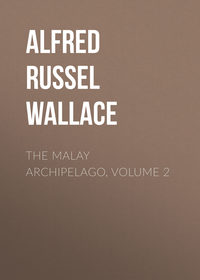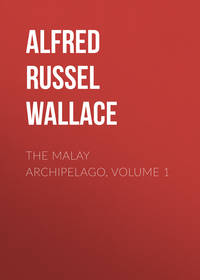 полная версия
полная версияContributions to the Theory of Natural Selection
In Mr. Trimen’s paper on “Mimetic Analogies among African Butterflies,” in the Transactions of the Linnæan Society, for 1868, he has argued strongly in favour of Mr. Bates’ views as to the higher position of the Danaidæ and the lower grade of the Papilionidæ, and has adduced, among other facts, the undoubted resemblance of the pupa of Parnassius, a genus of Papilionidæ, to that of some Hesperidæ and moths. I admit, therefore, that he has proved the Papilionidæ to have retained several characters of the nocturnal Lepidoptera which the Danaidæ have lost, but I deny that they are therefore to be considered lower in the scale of organization. Other characters may be pointed out which indicate that they are farther removed from the moths even than the Danaidæ. The club of the antennæ is the most prominent and most constant feature by which butterflies may be distinguished from moths, and of all butterflies the Papilionidæ have the most beautiful and most perfectly developed clubbed antennæ. Again, butterflies and moths are broadly characterised by their diurnal and nocturnal habits respectively, and the Papilionidæ, with their close allies the Pieridæ, are the most pre-eminently diurnal of butterflies, most of them lovers of sunshine, and not presenting a single crepuscular species. The great group of the Nymphalidæ, on the other hand (in which Mr. Bates includes the Danaidæ and Heliconidæ as sub-families), contains an entire sub-family (Brassolidæ) and a number of genera, such as Thaumantis, Zeuxidia, Pavonia, &c., of crepuscular habits, while a large proportion of the Satyridæ and many of the Danaidæ are shade-loving butterflies. This question, of what is to be considered the highest type of any group of organisms, is one of such general interest to naturalists that it will be well to consider it a little further, by a comparison of the Lepidoptera with some groups of the higher animals.
Mr. Trimen’s argument, that the lepidopterous type, like that of birds, being pre-eminently aërial, “therefore a diminution of the ambulatory organs, instead of being a sign of inferiority, may very possibly indicate a higher, because a more thoroughly aërial form,” is certainly unsound, for it would imply that the most aërial of birds (the swift and the frigate-birds, for example) are the highest in the scale of bird-organization, and the more so on account of their feet being very ill adapted for walking. But no ornithologist has ever so classed them, and the claim to the highest rank among birds is only disputed between three groups, all very far removed from these. They are—1st. The Falcons, on account of their general perfection, their rapid flight, their piercing vision, their perfect feet armed with retractile claws, the beauty of their forms, and the ease and rapidity of their motions; 2nd. The Parrots, whose feet, though ill-fitted for walking, are perfect as prehensile organs, and which possess large brains with great intelligence, though but moderate powers of flight; and, 3rd. The Thrushes or Crows, as typical of the perching birds, on account of the well-balanced development of their whole structure, in which no organ or function has attained an undue prominence.
Turning now to the Mammalia, it might be argued that as they are pre-eminently the terrestrial type of vertebrates, to walk and run well is essential to the typical perfection of the group; but this would give the superiority to the horse, the deer, or the hunting leopard, instead of to the Quadrumana. We seem here to have quite a case in point, for one group of Quadrumana, the Lemurs, is undoubtedly nearer to the low Insectivora and Marsupials than the Carnivora or the Ungulata, as shown among other characters by the Opossums possessing a hand with perfect opposable thumb, closely resembling that of some of the Lemurs; and by the curious Galeopithecus, which is sometimes classed as a Lemur, and sometimes with the Insectivora. Again, the implacental mammals, including the Ornithodelphia and the Marsupials, are admitted to be lower than the placental series. But one of the distinguishing characters of the Marsupials is that the young are born blind and exceedingly imperfect, and it might therefore be argued that those orders in which the young are born most perfect are the highest, because farthest from the low Marsupial type. This would make the Ruminants and Ungulata higher than the Quadrumana or the Carnivora. But the Mammalia offer a still more remarkable illustration of the fallacy of this mode of reasoning, for if there is one character more than another which is essential and distinctive of the class, it is that from which it derives its name, the possession of mammary glands and the power of suckling the young. What more reasonable, apparently, than to argue that the group in which this important function is most developed, that in which the young are most dependent upon it, and for the longest period, must be the highest in the Mammalian scale of organization? Yet this group is the Marsupial, in which the young commence suckling in a fœtal condition, and continue to do so till they are fully developed, and are therefore for a long time absolutely dependent on this mode of nourishment.
These examples, I think, demonstrate that we cannot settle the rank of a group by a consideration of the degree in which certain characters resemble or differ from those in what is admitted to be a lower group; and they also show that the highest group of a class may be more closely connected to one of the lowest, than some other groups which have developed laterally and diverged farther from the parent type, but which yet, owing to want of balance or too great specialization in their structure, have never reached a high grade of organization. The Quadrumana afford a very valuable illustration, because, owing to their undoubted affinity with man, we feel certain that they are really higher than any other order of Mammalia, while at the same time they are more distinctly allied to the lowest groups than many others. The case of the Papilionidæ seems to me so exactly parallel to this, that, while I admit all the proofs of affinity with the undoubtedly lower groups of Hesperidæ and moths, I yet maintain that, owing to the complete and even development of every part of their organization, these insects best represent the highest perfection to which the butterfly type has attained, and deserve to be placed at its head in every system of classification.
Distribution of the Papilionidæ
The Papilionidæ are pretty widely distributed over the earth, but are especially abundant in the tropics, where they attain their maximum of size and beauty, and the greatest variety of form and colouring. South America, North India, and the Malay Islands are the regions where these fine insects occur in the greatest profusion, and where they actually become a not unimportant feature in the scenery. In the Malay Islands in particular, the giant Ornithopteræ may be frequently seen about the borders of the cultivated and forest districts, their large size, stately flight, and gorgeous colouring rendering them even more conspicuous than the generality of birds. In the shady suburbs of the town of Malacca two large and handsome Papilios (Memnon and Nephelus) are not uncommon, flapping with irregular flight along the roadways, or, in the early morning, expanding their wings to the invigorating rays of the sun. In Amboyna and other towns of the Moluccas, the magnificent Deiphobus and Severus, and occasionally even the azure-winged Ulysses, frequent similar situations, fluttering about the orange-trees and flower-beds, or sometimes even straying into the narrow bazaars or covered markets of the city. In Java the golden-dusted Arjuna may often be seen at damp places on the roadside in the mountain districts, in company with Sarpedon, Bathycles, and Agamemnon, and less frequently the beautiful swallow-tailed Antiphates. In the more luxuriant parts of these islands one can hardly take a morning’s walk in the neighbourhood of a town or village without seeing three or four species of Papilio, and often twice that number. No less than 130 species of the family are now known to inhabit the Archipelago, and of these ninety-six were collected by myself. Thirty species are found in Borneo, being the largest number in any one island, twenty-three species having been obtained by myself in the vicinity of Sarawak; Java has twenty-eight species; Celebes twenty-four, and the Peninsula of Malacca, twenty-six species. Further east the numbers decrease; Batchian producing seventeen, and New Guinea only fifteen, though this number is certainly too small, owing to our present imperfect knowledge of that great island.
Definition of the word Species
In estimating these numbers I have had the usual difficulty to encounter, of determining what to consider species and what varieties. The Malayan region, consisting of a large number of islands of generally great antiquity, possesses, compared to its actual area, a great number of distinct forms, often indeed distinguished by very slight characters, but in most cases so constant in large series of specimens, and so easily separable from each other, that I know not on what principle we can refuse to give them the name and rank of species. One of the best and most orthodox definitions is that of Pritchard, the great ethnologist, who says, that “separate origin and distinctness of race, evinced by a constant transmission of some characteristic peculiarity of organization,” constitutes a species. Now leaving out the question of “origin,” which we cannot determine, and taking only the proof of separate origin, “the constant transmission of some characteristic peculiarity of organization,” we have a definition which will compel us to neglect altogether the amount of difference between any two forms, and to consider only whether the differences that present themselves are permanent. The rule, therefore, I have endeavoured to adopt is, that when the difference between two forms inhabiting separate areas seems quite constant, when it can be defined in words, and when it is not confined to a single peculiarity only, I have considered such forms to be species. When, however, the individuals of each locality vary among themselves, so as to cause the distinctions between the two forms to become inconsiderable and indefinite, or where the differences, though constant, are confined to one particular only, such as size, tint, or a single point of difference in marking or in outline, I class one of the forms as a variety of the other.
I find as a general rule that the constancy of species is in an inverse ratio to their range. Those which are confined to one or two islands are generally very constant. When they extend to many islands, considerable variability appears; and when they have an extensive range over a large part of the Archipelago, the amount of unstable variation is very large. These facts are explicable on Mr. Darwin’s principles. When a species exists over a wide area, it must have had, and probably still possesses, great powers of dispersion. Under the different conditions of existence in various portions of its area, different variations from the type would be selected, and, were they completely isolated, would soon become distinctly modified forms; but this process is checked by the dispersive powers of the whole species, which leads to the more or less frequent intermixture of the incipient varieties, which thus become irregular and unstable. Where, however, a species has a limited range, it indicates less active powers of dispersion, and the process of modification under changed conditions is less interfered with. The species will therefore exist under one or more permanent forms according as portions of it have been isolated at a more or less remote period.
Laws and Modes of Variation
What is commonly called variation consists of several distinct phenomena which have been too often confounded. I shall proceed to consider these under the heads of—1st, simple variability; 2nd, polymorphism; 3rd, local forms; 4th, co-existing varieties; 5th, races or subspecies; and 6th, true species.
1. Simple variability.—Under this head I include all those cases in which the specific form is to some extent unstable. Throughout the whole range of the species, and even in the progeny of individuals, there occur continual and uncertain differences of form, analogous to that variability which is so characteristic of domestic breeds. It is impossible usefully to define any of these forms, because there are indefinite gradations to each other form. Species which possess these characteristics have always a wide range, and are more frequently the inhabitants of continents than of islands, though such cases are always exceptional, it being far more common for specific forms to be fixed within very narrow limits of variation. The only good example of this kind of variability which occurs among the Malayan Papilionidæ is in Papilio Severus, a species inhabiting all the islands of the Moluccas and New Guinea, and exhibiting in each of them a greater amount of individual difference than often serves to distinguish well-marked species. Almost equally remarkable are the variations exhibited in most of the species of Ornithoptera, which I have found in some cases to extend even to the form of the wing and the arrangement of the nervures. Closely allied, however, to these variable species are others which, though differing slightly from them, are constant and confined to limited areas. After satisfying oneself, by the examination of numerous specimens captured in their native countries, that the one set of individuals are variable and the others are not, it becomes evident that by classing all alike as varieties of one species we shall be obscuring an important fact in nature; and that the only way to exhibit that fact in its true light is to treat the invariable local form as a distinct species, even though it does not offer better distinguishing characters than do the extreme forms of the variable species. Cases of this kind are the Ornithoptera Priamus, which is confined to the islands of Ceram and Amboyna, and is very constant in both sexes, while the allied species inhabiting New Guinea and the Papuan Islands is exceedingly variable; and in the island of Celebes is a species closely allied to the variable P. Severus, but which, being exceedingly constant, I have described as a distinct species under the name of Papilio Pertinax.
2. Polymorphism or dimorphism.—By this term I understand the co-existence in the same locality of two or more distinct forms, not connected by intermediate gradations, and all of which are occasionally produced from common parents. These distinct forms generally occur in the female sex only, and their offspring, instead of being hybrids, or like the two parents, appear to reproduce all the distinct forms in varying proportions. I believe it will be found that a considerable number of what have been classed as varieties are really cases of polymorphism. Albinoism and melanism are of this character, as well as most of those cases in which well-marked varieties occur in company with the parent species, but without any intermediate forms. If these distinct forms breed independently, and are never reproduced from a common parent, they must be considered as separate species, contact without intermixture being a good test of specific difference. On the other hand, intercrossing without producing an intermediate race is a test of dimorphism. I consider, therefore, that under any circumstances the term “variety” is wrongly applied to such cases.
The Malayan Papilionidæ exhibit some very curious instances of polymorphism, some of which have been recorded as varieties, others as distinct species; and they all occur in the female sex. Papilio Memnon is one of the most striking, as it exhibits the mixture of simple variability, local and polymorphic forms, all hitherto classed under the common title of varieties. The polymorphism is strikingly exhibited by the females, one set of which resemble the males in form, with a variable paler colouring; the others have a large spatulate tail to the hinder wings and a distinct style of colouring, which causes them closely to resemble P. Coon, a species having the two sexes alike and inhabiting the same countries, but with which they have no direct affinity. The tailless females exhibit simple variability, scarcely two being found exactly alike even in the same locality. The males of the island of Borneo exhibit constant differences of the under surface, and may therefore be distinguished as a local form, while the continental specimens, as a whole, offer such large and constant differences from those of the islands, that I am inclined to separate them as a distinct species, to which the name P. Androgeus (Cramer) may be applied. We have here, therefore, distinct species, local forms, polymorphism, and simple variability, which seem to me to be distinct phenomena, but which have been hitherto all classed together as varieties. I may mention that the fact of these distinct forms being one species is doubly proved. The males, the tailed and tailless females, have all been bred from a single group of the larvæ, by Messrs. Payen and Bocarmé, in Java, and I myself captured, in Sumatra, a male P. Memnon, and a tailed female P. Achates, under circumstances which led me to class them as the same species.
Papilio Pammon offers a somewhat similar case. The female was described by Linnæus as P. Polytes, and was considered to be a distinct species till Westermann bred the two from the same larvæ (see Boisduval, “Species Général des Lépidoptères,” p. 272). They were therefore classed as sexes of one species by Mr. Edward Doubleday, in his “Genera of Diurnal Lepidoptera,” in 1846. Later, female specimens were received from India closely resembling the male insect, and this was held to overthrow the authority of M. Westermann’s observation, and to re-establish P. Polytes as a distinct species; and as such it accordingly appears in the British Museum List of Papilionidæ in 1856, and in the Catalogue of the East India Museum in 1857. This discrepancy is explained by the fact of P. Pammon having two females, one closely resembling the male, while the other is totally different from it. A long familiarity with this insect (which replaced by local forms or by closely allied species, occurs in every island of the Archipelago) has convinced me of the correctness of this statement; for in every place where a male allied to P. Pammon is found, a female resembling P. Polytes also occurs, and sometimes, though less frequently than on the continent, another female closely resembling the male: while not only has no male specimen of P. Polytes yet been discovered, but the female (Polytes) has never yet been found in localities to which the male (Pammon) does not extend. In this case, as in the last, distinct species, local forms, and dimorphic specimens, have been confounded under the common appellation of varieties.
But, besides the true P. Polytes, there are several allied forms of females to be considered, namely, P. Theseus (Cramer), P. Molanides (De Haan), P. Elyros (G. R. Gray), and P. Romulus (Linnæus). The dark female figured by Cramer as P. Theseus seems to be the common and perhaps the only form in Sumatra, whereas in Java, Borneo, and Timor, along with males quite identical with those of Sumatra, occur females of the Polytes form, although a single specimen of the true P. Theseus taken at Lombock would seem to show that the two forms do occur together. In the allied species found in the Philippine Islands (P. Alphenor, Cramer = P. Ledebouria, Eschscholtz, the female of which is P. Elyros, G. R. Gray,) forms corresponding to these extremes occur, along with a number of intermediate varieties, as shown by a fine series in the British Museum. We have here an indication of how dimorphism may be produced; for let the extreme Philippine forms be better suited to their conditions of existence than the intermediate connecting links, and the latter will gradually die out, leaving two distinct forms of the same insect, each adapted to some special conditions. As these conditions are sure to vary in different districts, it will often happen, as in Sumatra and Java, that the one form will predominate in the one island, the other in the adjacent one. In the island of Borneo there seems to be a third form; for P. Melanides (De Haan) evidently belongs to this group, and has all the chief characteristics of P. Theseus, with a modified colouration of the hind wings. I now come to an insect which, if I am correct, offers one of the most interesting cases of variation yet adduced. Papilio Romulus, a butterfly found over a large part of India and Ceylon, and not uncommon in collections, has always been considered a true and independent species, and no suspicions have been expressed regarding it. But a male of this form does not, I believe, exist. I have examined the fine series in the British Museum, in the East India Company’s Museum, in the Hope Museum at Oxford, in Mr. Hewitson’s and several other private collections, and can find nothing but females; and for this common butterfly no male partner can be found except the equally common P. Pammon, a species already provided with two wives, and yet to whom we shall be forced, I believe, to assign a third. On carefully examining P. Romulus, I find that in all essential characters—the form and texture of the wings, the length of the antennæ, the spotting of the head and thorax, and even the peculiar tints and shades with which it is ornamented—it corresponds exactly with the other females of the Pammon group; and though, from the peculiar marking of the fore wings, it has at first sight a very different aspect, yet a closer examination shows that every one of its markings could be produced by slight and almost imperceptible modifications of the various allied forms. I fully believe, therefore, that I shall be correct in placing P. Romulus as a third Indian form of the female P. Pammon, corresponding to P. Melanides, the third form of the Malayan P. Theseus. I may mention here that the females of this group have a superficial resemblance to the Polydorus group of Papilios, as shown by P. Theseus having been considered to be the female of P. Antiphus, and by P. Romulus being arranged next to P. Hector. There is no close affinity between these two groups of Papilio, and I am disposed to believe that we have here a case of mimicry, brought about by the same causes which Mr. Bates has so well explained in his account of the Heliconidæ, and which has led to the singular exuberance of polymorphic forms in this and allied groups of the genus Papilio. I shall have to devote a section of my essay to the consideration of this subject.
The third example of polymorphism I have to bring forward is Papilio Ormenus, which is closely allied to the well-known P. Erechtheus, of Australia. The most common form of the female also resembles that of P. Erechtheus; but a totally different-looking insect was found by myself in the Aru Islands, and figured by Mr. Hewitson under the name of P. Onesimus, which subsequent observation has convinced me is a second form of the female of P. Ormenus. Comparison of this with Boisduval’s description of P. Amanga, a specimen of which from New Guinea is in the Paris Museum, shows the latter to be a closely similar form; and two other specimens were obtained by myself, one in the island of Goram and the other in Waigiou, all evidently local modifications of the same form. In each of these localities males and ordinary females of P. Ormenus were also found. So far there is no evidence that these light-coloured insects are not females of a distinct species, the males of which have not been discovered. But two facts have convinced me this is not the case. At Dorey, in New Guinea, where males and ordinary females closely allied to P. Ormenus occur (but which seem to me worthy of being separated as a distinct species), I found one of these light-coloured females closely followed in her flight by three males, exactly in the same manner as occurs (and, I believe, occurs only) with the sexes of the same species. After watching them a considerable time, I captured the whole of them, and became satisfied that I had discovered the true relations of this anomalous form. The next year I had corroborative proof of the correctness of this opinion by the discovery in the island of Batchian of a new species allied to P. Ormenus, all the females of which, either seen or captured by me, were of one form, and much more closely resembling the abnormal light-coloured females of P. Ormenus and P. Pandion than the ordinary specimens of that sex. Every naturalist will, I think, agree that this is strongly confirmative of the supposition that both forms of female are of one species; and when we consider, further, that in four separate islands, in each of which I resided for several months, the two forms of female were obtained and only one form of male ever seen, and that about the same time, M. Montrouzier in Woodlark Island, at the other extremity of New Guinea (where he resided several years, and must have obtained all the large Lepidoptera of the island), obtained females closely resembling mine, which, in despair at finding no appropriate partners for them, he mates with a widely different species—it becomes, I think, sufficiently evident this is another case of polymorphism of the same nature as those already pointed out in P. Pammon and P. Memnon. This species, however, is not only dimorphic, but trimorphic; for, in the island of Waigiou, I obtained a third female quite distinct from either of the others, and in some degree intermediate between the ordinary female and the male. The specimen is particularly interesting to those who believe, with Mr. Darwin, that extreme difference of the sexes has been gradually produced by what he terms sexual selection, since it may be supposed to exhibit one of the intermediate steps in that process, which has been accidentally preserved in company with its more favoured rivals, though its extreme rarity (only one specimen having been seen to many hundreds of the other form) would indicate that it may soon become extinct.









